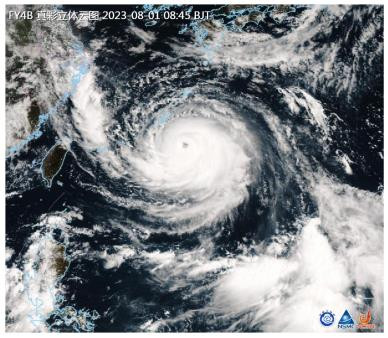Extreme weather is wreaking havoc across Asia, influenced by El Niño events and climate change. The Northern Hemisphere is experiencing extreme heat this summer. Last week, several Asian countries were hit by a powerful typhoon, high temperatures, and heavy rainfall.
Philippines, Taiwan, and China Face Typhoon Assault
The super typhoon named "Dusuari" was formed east of the Philippines last week, moving northwest to hit the Philippines, Taiwan, and later making landfall in Fujian province, China. On July 29, Dusuari weakened to a tropical depression in Anhui province, leading the China Meteorological Administration to stop tracking it.
Despite this, the remnants of Dusuari continued north, sparking extreme heavy rainfall in Beijing, Tianjin, and Hebei. By August 1, the typhoon had led to the deaths of 11 people in Beijing, nine in Hebei, and one in Taiwan, with over 1.45 million people affected in Fujian province.
In the Philippines, the death toll from Dusuari rose to 26, with over 2.45 million affected, and hundreds of towns declared disaster zones.
Another Super Typhoon Looms Over Japan and China
As Dusuari's impacts faded, another super typhoon, "Kanu," was closing in on the southwestern region of Okinawa, Japan. Forecasts suggest that Kanu will enter the East China Sea and gradually approach the coasts of Zhejiang and Fujian provinces in China.
Meanwhile, South Korea is in the throes of a heatwave that has killed at least 15 people. In the previous month, mudslides and flooding triggered by heavy rainfall had resulted in the deaths of at least 47 people in the country.
As reported by NHK, Japan's national broadcasting organization, by Tuesday morning, August 1, Kanu was just 220 kilometers northeast of Naha, the capital of Okinawa prefecture, moving slowly toward the city with peak winds of 162 kilometers per hour near its center.
The Japan Meteorological Agency predicted that Kanu would bring strong winds to Okinawa and the Amami Oshima region on Tuesday, with wind speeds in Okinawa reaching 144 kilometers per hour. On Wednesday, gusts in Okinawa were expected to peak at 234 kilometers per hour, potentially causing damage to some houses.
From Tuesday through Thursday, Okinawa and Amami Oshima were also predicted to face torrential rain. By Wednesday morning, rainfall in Okinawa could reach 180 millimeters, and in Amami Oshima, 120 millimeters. The Japan Meteorological Agency warned that Kanu could cause a sudden rise in sea levels, possibly flooding low-lying coastal and estuarine areas.
Response Measures to Super Typhoon Kanu
In preparation for Kanu, Naha airport in Okinawa was closed and over 900 flights were cancelled. Naha City Hall closed on Tuesday, and local supermarkets shortened their business hours. In the afternoon, Naha City issued an evacuation order to 158,000 households, urging residents to seek refuge.
The US's Kadena Air Force Base, located southwest of Okinawa Island, predicted that Kanu would pass about 100 kilometers from the base by 5 a.m. Wednesday. The base referred to Kanu as the strongest typhoon it had encountered in five years, suggesting possible power outages and flooding in some low-lying areas.
The Kadena Air Base is the largest U.S. air base in the Far East, equipped with hundreds of military aircraft. Base officials stated they were prepared for the impact of the typhoon on their aircraft, although they did not disclose whether the aircraft had been relocated.
The latest forecast from the China Meteorological Administration on Tuesday indicated that after leaving Okinawa, Kanu would move into the East China Sea on Wednesday morning. The path of Kanu remains uncertain once it enters the East China Sea; it could approach the coasts of Zhejiang and Fujian or possibly make landfall in China.
South Korea's Deadly Heatwave Amid Typhoon Threats
While Japan and China were grappling with the impending typhoons, South Korea was experiencing a brutal heatwave. According to the Korean news agency Yonhap, at least 15 people died of heatstroke from July 29 to 30 alone. Most of the victims were elderly and fell ill while working in the fields.
High-temperature warnings were issued across South Korea from the end of July. By the weekend, several cities reported their highest temperatures of the year, with Gangnam district in Seoul reaching 35.7 degrees Celsius and Gyeongsangbuk-do hitting 38.1 degrees Celsius.
South Korea's weather agency predicted that the high temperatures would last until early August, with temperatures exceeding 35 degrees Celsius in many areas from the beginning of this week. Between early and mid-July, South Korea experienced heavy rainfall, resulting in the deaths of 47 people and flooding of farmland equivalent to half the area of Seoul.
According to statistics released last month by the American insurance company Aon, the economic losses caused by natural disasters worldwide in the first half of this year reached $194 billion, far exceeding the average of $128 billion since the 21st century.
The report pointed out that nearly half of the economic losses from natural disasters in the first half of the year were due to earthquakes in Turkey and Syria in February. However, of the 25 disaster events causing economic losses exceeding $1 billion, 24 were weather-related.






